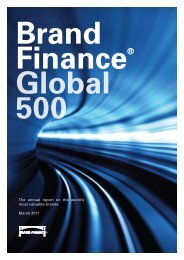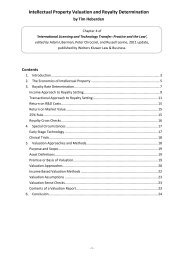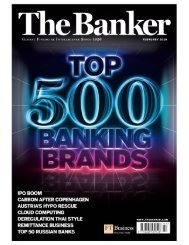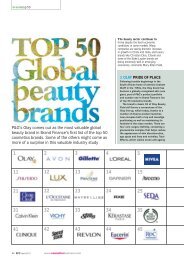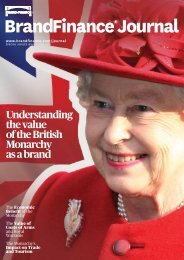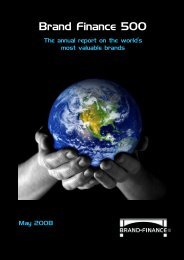top 10 most valuable banking brands in the world - Brand Finance
top 10 most valuable banking brands in the world - Brand Finance
top 10 most valuable banking brands in the world - Brand Finance
You also want an ePaper? Increase the reach of your titles
YUMPU automatically turns print PDFs into web optimized ePapers that Google loves.
The methodology employed <strong>in</strong> this <strong>Brand</strong>F<strong>in</strong>ance ®<br />
Bank<strong>in</strong>g 500 list<strong>in</strong>g uses a discounted cash flow<br />
(DCF) technique to discount estimated future<br />
royalties, at an appropriate discount rate, to arrive<br />
at a net present value (NPV) of <strong>the</strong> trademark<br />
and associated <strong>in</strong>tellectual property: <strong>the</strong> brand<br />
value.<br />
The steps <strong>in</strong> this process are:<br />
• Obta<strong>in</strong> brand-specific f<strong>in</strong>ancial and revenue<br />
data. The revenue was <strong>the</strong>n segmented <strong>in</strong>to<br />
<strong>the</strong> follow<strong>in</strong>g revenue streams: retail <strong>bank<strong>in</strong>g</strong>,<br />
commercial <strong>bank<strong>in</strong>g</strong>, wholesale/<strong>in</strong>vestment<br />
<strong>bank<strong>in</strong>g</strong>, <strong>in</strong>surance, asset management and<br />
credit cards.<br />
• Model <strong>the</strong> market to identify market demand and<br />
<strong>the</strong> position of <strong>in</strong>dividual banks <strong>in</strong> <strong>the</strong> context of<br />
all o<strong>the</strong>r market competitors.<br />
Three forecast periods were used:<br />
- Estimated f<strong>in</strong>ancial results for 20<strong>10</strong> us<strong>in</strong>g<br />
Institutional Brokers Estimate System (IBES)<br />
consensus forecast.<br />
- A five-year forecast period (2011-2015),<br />
based on three data sources (IBES, historic<br />
growth and GDP growth).<br />
- Perpetuity growth, based on a comb<strong>in</strong>ation<br />
of growth expectations (GDP and IBES).<br />
• Establish <strong>the</strong> royalty rate for each bank.<br />
This is done by:<br />
- Calculat<strong>in</strong>g brand strength – on a scale of<br />
0 to <strong>10</strong>0 – accord<strong>in</strong>g to a number of attributes<br />
such as asset strength, emotional connection,<br />
market share and profitability, among o<strong>the</strong>rs.<br />
- Determ<strong>in</strong><strong>in</strong>g <strong>the</strong> royalty rate for each of <strong>the</strong><br />
revenue streams mentioned <strong>in</strong> step 1.<br />
- Calculate future royalty <strong>in</strong>come stream.<br />
• Calculate <strong>the</strong> discount rate specific to each bank,<br />
tak<strong>in</strong>g account of its size, geographical presence,<br />
reputation, gear<strong>in</strong>g and brand rat<strong>in</strong>g (see below).<br />
• Discount future royalty stream (explicit forecast<br />
and perpetuity periods) to a net present value –<br />
ie: <strong>the</strong> brand value.<br />
1<br />
2<br />
3<br />
4<br />
Rev Forecast<br />
5<br />
- X<br />
X RR tax<br />
Discount Rate<br />
NPV<br />
Explanation of <strong>the</strong><br />
Methodology<br />
Royalty Relief Approach<br />
<strong>Brand</strong> F<strong>in</strong>ance uses <strong>the</strong> royalty relief methodology<br />
that determ<strong>in</strong>es <strong>the</strong> value of <strong>the</strong> brand <strong>in</strong> relation to<br />
<strong>the</strong> royalty rate that would be payable for its use were<br />
it owned by a third party. The royalty rate is applied<br />
to future revenue to determ<strong>in</strong>e an earn<strong>in</strong>gs stream<br />
that is attributable to <strong>the</strong> brand. The brand earn<strong>in</strong>gs<br />
stream is <strong>the</strong>n discounted back to a net present<br />
value.<br />
The royalty relief approach is used for three reasons: it<br />
is favoured by tax authorities and <strong>the</strong> courts because<br />
it calculates brand values by reference to documented<br />
third-party transactions; it can be done based on publicly<br />
available f<strong>in</strong>ancial <strong>in</strong>formation; and it is compliant to <strong>the</strong><br />
requirement under <strong>the</strong> International Valuation Standards<br />
Committee (IVSC) to determ<strong>in</strong>e Fair Market Value of<br />
<strong>brands</strong>.<br />
<strong>Brand</strong> Rat<strong>in</strong>gs<br />
These are calculated us<strong>in</strong>g <strong>Brand</strong> F<strong>in</strong>ance’s<br />
ßrandßeta ® analysis, which benchmarks <strong>the</strong> strength,<br />
risk and future potential of a brand relative to its<br />
competitors on a scale rang<strong>in</strong>g from AAA to D. It is<br />
conceptually similar to a credit rat<strong>in</strong>g.<br />
The data used to calculate <strong>the</strong> rat<strong>in</strong>gs comes from<br />
various sources <strong>in</strong>clud<strong>in</strong>g Bloomberg, annual reports<br />
and <strong>Brand</strong> F<strong>in</strong>ance research.<br />
<strong>Brand</strong> Rat<strong>in</strong>gs Def<strong>in</strong>itions<br />
AAA Extremely strong<br />
AA Very strong<br />
A Strong<br />
BBB-B Average<br />
CCC-C Weak<br />
DDD-D Fail<strong>in</strong>g<br />
Valuation Date<br />
All brand values <strong>in</strong> <strong>the</strong> report are for <strong>the</strong> end of <strong>the</strong><br />
year, 31st December 20<strong>10</strong>.<br />
26 © <strong>Brand</strong> F<strong>in</strong>ance plc 2011



